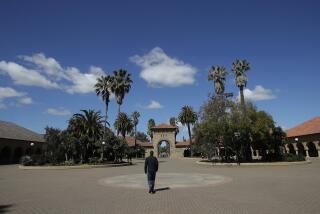Despite Financial Aid and Open Policies, Top Schools Are High Hurdles for Poor : College: Family wealth and social disparities still put higher education out of the reach of many.
AMHERST, Mass. — He studies literature and political theory at Amherst College, but Angel Ortiz often thinks about gunshots, food stamps, welfare and where to find cash for his next trip home.
Like many children of poverty who have climbed to the upper echelons of American education, the 21-year-old senior, who grew up in a squalid New York City housing project, remains bound by economic and emotional chains.
Educators and advocates say wealth and social disparities still make higher education an unequal opportunity in the 1990s--even at top schools with deep pockets and fierce commitments to fairness.
“The reality of the Bronx is my reality,” Ortiz said. “I am grateful to be here, but in a lot of ways I feel I shouldn’t be. My mind tells me I should be home helping my family. I should be working. I should be dead.”
According to the U.S. Census Bureau, 9.4% of U.S. families had incomes less than $10,000 in 1990. But in 1991, only 6% of freshmen at private, four-year colleges, and 2.8% at private universities, came from families earning less than $10,000.
Ortiz could easily have missed their ranks. He grew up amid decay and gang violence. His father often was without work. His family survived on food stamps.
His mother, now separated from his father, still lives on welfare with six of Ortiz’s seven brothers and sisters.
He took the first step out of poverty when he caught the eye of Prep for Prep, a private group that directs low-income students to top schools. With its help, Ortiz gained a scholarship at a private high school in Manhattan and later enrolled at Amherst, one of the country’s top liberal arts colleges.
“I think a lot of young people like Angel end up at community colleges or not going past high school,” said Gary Simons, Prep for Prep’s director. “Some of them unfortunately get pulled into the negative stuff that goes on in the neighborhood.”
It has taken tens of thousands of dollars, in addition to Ortiz’s own exceptional talents and commitment, to propel him.
Like many other disadvantaged students at leading schools, Ortiz receives nearly all his tuition--about $17,000 this year--in scholarship from the college. He uses nearly $4,000 in state and federal grants for low-income students to cover room, board, books and living expenses.
Still, he finds himself without ready money for trips home in emergencies, such as when his brother was beaten up or his mother got sick with cancer. He has worn the same pair of sneakers for years.
Despite his intellectual growth and B average, Ortiz says he has always felt out of place in the rolling hills, cloistered classrooms and old-money affluence of the western Massachusetts college. He worries about finances every day.
“Even if I become a millionaire, I will always be poor because . . . I will always have a fear,” he said.
The costs of top colleges intimidate many low-income students from even applying. Total expenses for a year at Amherst are estimated at $21,545. At nearby Smith College, they are $21,870.
“Just saying that is so forbidding,” said Maureen Hoyler, an official at the National Council of Educational Opportunity Associations. “It’s so otherworldly that you just don’t go out and say, ‘I’m going to Amherst.’ ”
If they do apply, low-income students are forced to borrow ever-greater sums to make up the difference between quickly rising costs and slowly rising federal and state grants, said Ann Wright, dean of enrollment at Smith College.
The hurdles also include racism, prejudice and simple social alienation.
“Here are kids hopping on a plane or train and going home for the weekend,” said William H. Gray, president of the United Negro College Fund. “Here are kids going to Boston or to New York . . . to Broadway and the theater. It’s a totally different world.”






